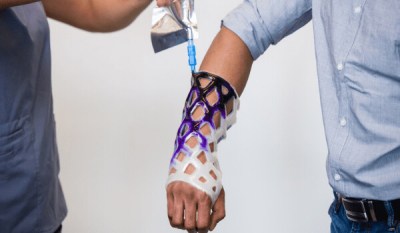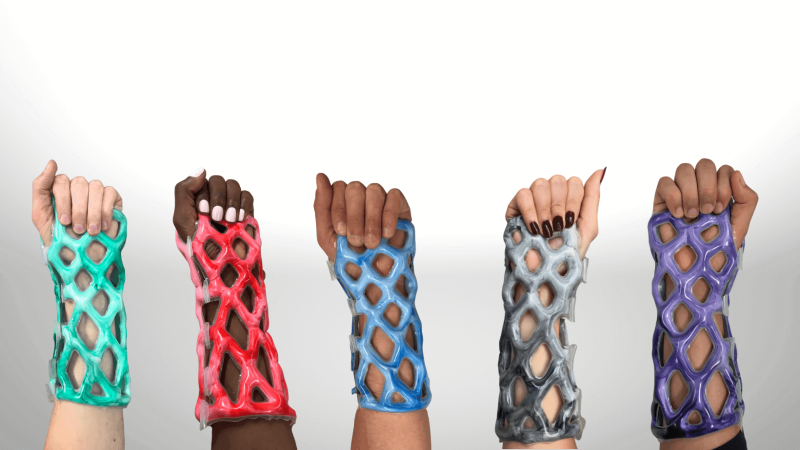It takes but an ill-fated second to break a bone, and several long weeks for it to heal in a cast. And even if you have one of those newfangled fiberglass casts, you still can’t get the thing wet, and it’s gonna be itchy under there because your skin can’t breathe. Isn’t it high time for something better?
Enter Cast21, co-founded by Chief Technical Officer [Jason Troutner], who has been in casts more than 50 times due to sports injuries and surgeries. He teamed up with a biomedical design engineer and an electrical engineer to break the norms associated with traditional casts and design a new solution that addresses their drawbacks.
 So, how does it work already? The latticework cast is made from a network of silicone tubes that harden once injected with resin and a catalyst mixture. It takes ten seconds to fill the latticework with resin and three minutes for it to cure, and the whole process is much faster than plaster or fiberglass.
So, how does it work already? The latticework cast is made from a network of silicone tubes that harden once injected with resin and a catalyst mixture. It takes ten seconds to fill the latticework with resin and three minutes for it to cure, and the whole process is much faster than plaster or fiberglass.
This new cast can be used along with electrical stimulation therapy, which can reduce healing time and prevent muscle atrophy.
Cast21 is not only breathable, it’s also waterproof, meaning no more trash bags on your arm to take a shower. The doctor doesn’t even need a saw to remove it, just cut in two places along the seam. It can even be used as a splint afterward.
It’s great to see advancements in simple medical technologies like the cast. And it looks almost as cool as this 3D-printed exoskeleton cast we saw ten years ago.
Thanks to [Keith Olson] for the tip!
















There is significantly less surface area to collect artwork.
But you may get a funny tan pattern.
Or a sexy leopard skin tan pattern.
where are we supposed to write dirty jokes?
A series of tubes? So this is like the internet, but for limbs?
There’s a joke about Internet centralisation in here somewhere. You’ve got 2 bones, you connect them together, over time they become 1 big bone… I’ll keep at it.
You’re dangerously close to rule 34…
It’s only nonheteronormative if balls are touching.
but is there a pipes and tubes cast for the backbone?
Great invention! Just a small article correction: “just cut in two places along the seam.” — does not matter much but it is in fact 5 or so. The “two” comes from a leaflet where two arrows indicate where the seam is.
Fun fact: (c) 2021 and it is in use in our (mid-Europe) hospitals since at latest 2022.
So similar I can’t tell the difference
Product photos look like CGI mock ups, probably vaporware
I guess it has been tested quite extensively, but imo there is less material that’s in contact with the skin/arm. Doesn’t that mean that it will have a higher pressure on the skin where it contacts?
I’ve been in a cast twice, the first one was for 13 weeks :/. No joke at all. I had to have plates and screws and they had to make an almost 40cm long cut on my leg. 13 weeks of agony, not just the smell and the itching, but also lots of painful stinging when the nerves started to grow back. And after 13 weeks, it turned out that my cast had been pressing on one point too much. When the cast was removed, I watched the blood return and then the small blood vessels on top of the skin literally started to explode. Within a few seconds the skin on my foot was full of tiny red dots, and I’m sure that some damage was done. A whole part of my foot doesn’t have any feeling in the skin.
If this cast works as great as they say, then it is a revolution. And I wish they had invented it in the 1990’s. :)
I had a start-up looking to 3D print these splints as a patient went into x-ray. The idea being that a physician could mark up the scan and specifically indicate the portions of the body that needed to be exposed. This would allow for wound exposure and care, and allow common pressure points to be addressed. We had to build a new printer (An almost two meter tall delta), which was a great challenge.
The actual material cost of the splint is minimal, compared to current technologies. The logistics chain for the splint is short and simple (but there is a larger logistics chain for the printers and scanners). But this cheap splint cost allows for modification and reprinting of the splint, literally on demand.
From a care-giver standpoint, being able to see the majority of the splinted limb and assess the skin and any wounds is a game changer. Much of the discomfort of the splint is eliminated, and significant lifestyle challenges are eliminated as well (The splint is waterproof by nature). We had some material challenges that were solved by some cool filaments, including a medical grade nylon. We were on track to deliver our second printer to our venture capital partners (And get the sweet, sweet injection of capital into the project…), when a major printing company did a major press piece about 3D printing for medicine, and their entry into the field. It was one of the identified endpoints for our endeavor, and ohhhhhhh that hurt.
But this is a phenomenal idea, and I’m upset that we shuttered over ten years ago, and we still aren’t seeing this tech.
I see this as away to combat the nacelle droop in the old AMT Enterprise models.
Glue the model together—drill a hole-and inject this stuff in the hollows—and it cures freezing its positioning in a jig.
Hey Round2!
And the even more environmentally-friendly version: https://www.woodcast.com/
Is there a cast21 for a foot/ankle yet??? I’m really hoping so.